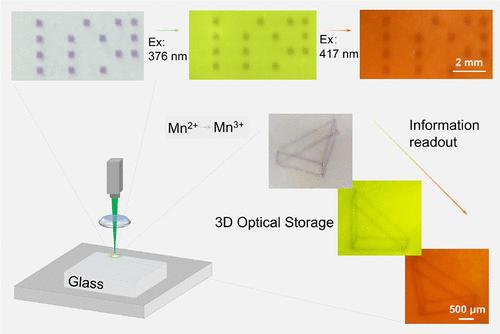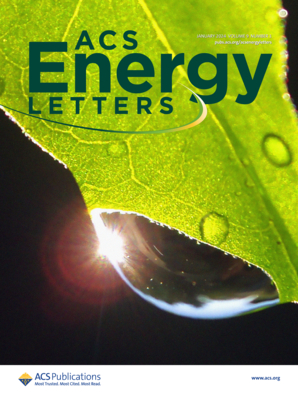Direct 3D Lithography of Reversible Photochromic Patterns with Tunable Luminescence in Amorphous Transparent Media
IF 19.3
1区 材料科学
Q1 CHEMISTRY, PHYSICAL
引用次数: 0
Abstract
The integration of reversible photochromism and multicolor luminescence modulation in transparent glass offers significant potential for high-capacity, nonvolatile 3D optical storage. However, achieving effective multicolor luminescence modulation and 3D patterning remains a challenge. This study introduces a Mn2+/Sb5+ charge compensation mechanism to induce purple photochromism in gallium silicate glass via the Mn2+ → Mn3+ transition under 532 nm laser irradiation. The effect is fully reversible, with efficient thermal erasure. By codoping Tb3+ and Mn2+, wavelength-independent red and green luminescence modulation enables multidimensional optical encoding. Arbitrary 3D photochromic patterns are directly inscribed using a 532 nm laser and decoded via tunable luminescence. This multimodal system advances 4D optical storage by combining 3D spatial dimensions with tunable luminescence intensity multiplexing. Mn2+/Tb3+ doped gallium silicate glass represents a breakthrough for 3D information display, data encryption, and insights into photochromic mechanisms in transition-metal-doped photonic systems.

求助全文
约1分钟内获得全文
求助全文
来源期刊

ACS Energy Letters
Energy-Renewable Energy, Sustainability and the Environment
CiteScore
31.20
自引率
5.00%
发文量
469
审稿时长
1 months
期刊介绍:
ACS Energy Letters is a monthly journal that publishes papers reporting new scientific advances in energy research. The journal focuses on topics that are of interest to scientists working in the fundamental and applied sciences. Rapid publication is a central criterion for acceptance, and the journal is known for its quick publication times, with an average of 4-6 weeks from submission to web publication in As Soon As Publishable format.
ACS Energy Letters is ranked as the number one journal in the Web of Science Electrochemistry category. It also ranks within the top 10 journals for Physical Chemistry, Energy & Fuels, and Nanoscience & Nanotechnology.
The journal offers several types of articles, including Letters, Energy Express, Perspectives, Reviews, Editorials, Viewpoints and Energy Focus. Additionally, authors have the option to submit videos that summarize or support the information presented in a Perspective or Review article, which can be highlighted on the journal's website. ACS Energy Letters is abstracted and indexed in Chemical Abstracts Service/SciFinder, EBSCO-summon, PubMed, Web of Science, Scopus and Portico.
 求助内容:
求助内容: 应助结果提醒方式:
应助结果提醒方式:


